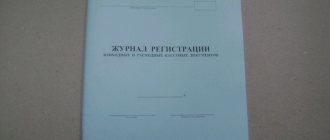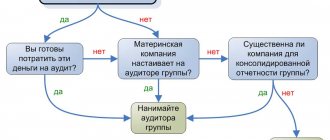The purpose and objectives of the audit of cash transactions
Any audit is a check of the compliance of a process with established standards. An audit of cash transactions is no exception. But in addition, it is necessary to take into account the specifics of the site - working with cash.
Checking compliance with the procedure for conducting cash transactions solves the following problems:
- control over the safety of money and other valuables;
- checking the initial paperwork for cash handling;
- checking accounting of cash transactions;
- inventory tracking;
- control over the use of cash register equipment (CCT);
- checking compliance with limits.
Checking cash handling can be carried out both by specialists of the enterprise itself and by employees of external companies.
In general, the law does not provide for a mandatory audit of cash transactions. But if the company falls under the general criteria for mandatory audit (Article 5 of Law No. 307-FZ dated December 30, 2008), then the inspectors, of course, will not ignore cash documents.
How to choose an audit company and why is the rating of the largest not the only criterion?
Regulatory regulation
The legislation of the Russian Federation quite strictly regulates the norms of legal relationships when conducting an audit. The main documents by which such relationships are regulated are Federal Law No. 129 of November 21, 1996 and Federal Law No. 54 of May 22, 2003.
Various departments have issued several decisions and documents regulating narrower operations when conducting cash audits:
- Letter from the Ministry of Finance of the Russian Federation dated August 30, 1993 on the basic rules when working with cash register equipment when servicing customers and clients.
- Regulations of the Bank of the Russian Federation dated January 5, 1998 “On the main methods of moving cash financial resources across the territory of the Russian Federation.”
- Instructions of the Bank of the Russian Federation dated June 20, 2007 “On the size of maximum tranches between legal entities.”
- Resolutions of the State Statistics Committee of Russia regulating the forms of documents with the help of which the primary accounting of financial resources is carried out.
How to fill out a cashier-operator certificate report - see this article. Read about how to fill out a sales receipt correctly here.
Methods for checking cash transactions
Because We are talking about working with valuables, then first of all it is necessary to take an inventory of them. When analyzing accounting documents, continuous, selective or combined methods are used.
Due to the importance of this area, the audit of cash transactions and monetary documents is most often carried out through a complete inspection.
But if the amount of work is very large, then a combined method can be used. In this case, only individual periods are completely checked, for example, those for which there is information about possible violations.
More details
Check program
An audit of cash transactions begins with drawing up a program for its implementation.
The audit plan for cash transactions includes introductory, main and final stages.
Let's consider the order of each of them. Introductory stage. At this stage, the auditor gets acquainted with the documentation.
It is recommended to follow the following procedure:
- checking compliance with documentation rules;
- recalculation of cash in the cash register;
- monitoring compliance with the procedure for working with cash register equipment;
- monitoring compliance with the rules for registering the movement of funds;
- monitoring the organization of cash storage.
Main stage. At the main stage, the auditor checks the company’s cash, finding out:
- whether an inventory was carried out when necessary circumstances arose (execution of an annual report, changes in employees bearing financial responsibility, detection of shortages, etc.);
- whether the established cash limit is observed;
- is the amount of settlements established by law observed when working with legal entities;
- Is the procedure for registering receipt and disbursement of money followed?
- whether the control and computer equipment has been registered with the tax office;
- Are the rules for storing free money in the cash register observed?
The final stage. At the end of the audit, an audit report is generated, a list of errors and inaccuracies to be corrected is compiled, and advice is given on improving record keeping, organizing document flow, and improving the skills of specific employees.
Check procedure
Any audit begins with drawing up an audit plan.
At this stage, the scope of work is assessed, the techniques to be used are selected, and an audit flowchart is drawn up.
The procedure for conducting a cash register audit consists of the following stages:
- Inventory. The verification procedure at this stage also includes monitoring the storage conditions of valuables. It should be noted here that the procedure for storing money at each enterprise is determined by the manager. Directive of the Central Bank of the Russian Federation dated March 11, 2014 No. 3210-U does not contain general requirements for cash register equipment. Therefore, the compliance of the cash register premises with the internal regulations of the organization is checked.
- Checking general internal company documents regulating cash handling. These include, for example, the rules for storing valuables in the cash register, mentioned in the previous paragraph. Also, the organization must have a job description for the cashier and an agreement with him, providing for full financial responsibility.
- Primary check. Here, compliance with the forms used and the correctness of their completion are monitored. Today, most forms of primary organizations can be developed by themselves. But this does not apply to cash documents - they must be filled out in strict accordance with instructions No. 3210-U. Individual entrepreneurs may not adhere to the requirements of the Central Bank of the Russian Federation. But in practice, individual entrepreneurs often still work with cash on a general basis, because this makes it easier to control the movement of money.
- Accounting audit. All primary data must be accurately transferred to accounting registers, and account balances must correspond to the actual availability of funds in the cash register. It is also necessary to check compliance with the cash balance limit. Its enterprises calculate independently, in accordance with the appendix to instruction No. 3210-U. Individual entrepreneurs have the right not to set a cash limit.
Important!
Individual entrepreneurs can accumulate funds in the cash register without restrictions (clause 2 of Directive No. 3210-U). At the same time, if a small enterprise does not take advantage of this right and sets a limit, then it will be obliged to comply with it (Letter of the Bank of Russia dated December 8, 2014 No. 29-1-1-6/9698).
- Checking the inventory. The frequency of cash inventories is established by the head of the enterprise and is fixed in the accounting policy or in a separate regulation. There are also situations when inventory is required: before submitting reports, when changing cashiers, etc. It is necessary to check compliance with frequency, execution of acts (INV-15 form) and reflection of identified deviations in accounting.
- If an organization works with the public, then you need to check the procedure for using cash registers . The current version of the law dated May 22, 2003 No. 54-FZ (“On the use of cash registers…”) provides for a phased transition to a new type of technology (online cash registers) during 2017-2021. The deadlines from which it is necessary to use online cash registers depend on the category (organization or individual entrepreneur), type of activity and tax regime. Therefore, as part of the audit, it is necessary to monitor the timeliness of updating cash register equipment, taking into account the characteristics of the company being audited.
- Sometimes organizations and entrepreneurs pay in cash and among themselves. Then, when auditing settlement transactions, you need to ensure that the volume of cash payments for one transaction does not exceed 100 thousand rubles.
Audit of transactions with cash and financial investments
An audit of cash transactions includes checking cash, banking and foreign exchange transactions. The main purpose of the audit is to establish the legality, reliability and expediency of transactions with funds at the enterprise, and the correctness of their reflection in accounting. At most enterprises, the volume of cash transactions is quite significant. Therefore, checking such operations is a labor-intensive process that requires increased attention from auditors, although the procedures themselves are quite simple.
Sources of information for checking transactions with funds are: cash book (form No. KO-4), book of accounting of funds accepted and issued by the cashier (form No. KO-5), journal of registration of incoming and outgoing cash documents (form No. KO -3), cashier's reports with attached primary documents (receipt cash orders (form No. K.O-1), outgoing cash orders (form No. KO-2), settlement and payment slips (form No. 49), pay slips (form No. 53), receipts, etc.), information about open ruble and foreign currency accounts of the enterprise, check money books, bank statements for ruble and foreign currency accounts with attached primary documents (invoices, payment orders, payment requests-orders, advice notes and etc.), acts of inventory of cash (form No. INV-15), inventory lists of securities and forms of strict reporting documents (form No. INV-16), etc., accounting registers (magazines-orders, statements, machine diagrams) for accounts 50, 51, 52, 55, 57, etc., General Ledger, Regulations on the accounting policy of the enterprise, etc.
Starting to check transactions with. cash, auditors should confirm the initial assessment of the internal control and accounting systems for these transactions. One way to obtain data is to test using a pre-prepared questionnaire.
Based on the test results, the actual attitude of the administration to the organization of accounting, ensuring the safety and intended use of funds in the enterprise is established. The resulting assessment is compared with the initial assessment formulated at the audit planning stage. If such an estimate turns out to be lower than the initial one, then it is necessary to adjust the scope and order of other audit procedures.
During the audit of cash transactions, the following tasks are solved:
— study of the actual procedure for documenting transactions for the receipt and expenditure of funds, maintaining a cash book, and accounting for cash transactions;
— checking compliance with cash discipline (timeliness and completeness of posting cash at the cash desk and returning excess cash balances to the bank, established rules for cash settlements with legal entities, the procedure for issuing and returning impounded amounts to the cash desk, the intended use of funds received from the bank by checks (including foreign exchange), the use of cash registers);
— familiarization with the conditions for storing cash, securities and other monetary documents at the cash desk.
In the process of checking cash transactions, auditors determine the correctness of their documentation: completeness of filling in the details of receipt and expense documents; their mandatory registration; presence of signatures of responsible persons and recipients of funds; absence of corrections, erasures, etc. To do this, the cashier's reports with the attached primary documents, the cash book and the journal for recording incoming and outgoing cash documents are studied. If the enterprise's accounting of cash transactions is computerized and a cash diary is kept instead of a cash book, auditors must verify independently or with the assistance of an expert that the program is protected from unauthorized access by the cashier and other persons in order to change the numbering of documents.
Next, auditors establish the legality of cash transactions and their compliance with the requirements of regulatory documents. Depending on the volume of cash transactions and the degree of confidence of auditors in the internal control system at the enterprise, a complete or selective check of cash documents can be carried out. The sample, as a rule, includes all documents for one or the other quarter, or for one month in each quarter of the reporting period. If the share of errors and incorrectly executed documents exceeds the share justified in the internal standards of the audit organization (for example, 5%), it is advisable to check the remaining cash documents.
When checking cash transactions, special attention is paid to ascertaining the completeness, timeliness and correctness of the posting of cash as a result of receipts from the bank, return of accountable amounts, revenue, rent payments and other operational and | non-operating income. Receipts from the bank are verified by reconciling identical amounts recorded on check stubs, bank statements and cash receipts. The receipt of revenue is studied by reconciling the amounts in cash receipt orders, invoices and invoices, cash register tapes, etc. The return of unused advances is analyzed using cash receipt orders. Operating and non-operating income must be confirmed by relevant agreements, acts, and certificates.
When checking the expenditure of cash from the cash register, auditors should pay attention to the legal validity of the issuance of money, that is, the presence of orders and instructions for bonuses to employees, for the provision of financial assistance, for business trips, for the issuance of funds for entertainment expenses, powers of attorney from third-party enterprises and organizations , writs of execution, etc. The intended use of funds received from the bank by check is also established (for wages, for the payment of various benefits, for travel, business, entertainment expenses, etc.), compliance with the cash limit.
At the same time, it is necessary to check the validity of the allocation of VAT in cash receipts and expenditure documents and its reflection in accounting. Compliance with the established limit for cash payments between legal entities is also clarified. The facts of payment to employees for business expenses incurred without preparing advance reports, repeated payments according to previously executed documents, payments to “dummy” persons, misappropriation of sums of money using forged documents, etc. are established.
The correctness of the correspondence accounts indicated in the accounting registers for account 50 "Cash" is established by comparing them with the schemes provided for in the Chart of Accounts for such operations. Arithmetic control is also carried out for the correctness of the calculation of turnover and account balances, for which the data of the cash book, the cashier's report and the accounting register for the corresponding month of the audited period by date. The identified discrepancies between the compared indicators indicate the presence of errors, which can be either unintentional, caused by the accountant’s inattention when calculating, or intentional. The latter require written explanations and prompt notification to the head of the enterprise. In any case, errors and unreliable data discovered by auditors are necessarily recorded in their working documents and their quantitative impact on the financial statements is determined.
In conclusion, the organization of analytical accounting of all monetary documents stored at the enterprise (vouchers, travel tickets, purchased own shares, etc.) and the procedure for recording their movement are checked. To do this, the primary documents documenting transactions for the movement of monetary documents are reconciled with the accounting register data in account 50-3 “Cash Documents”.
Audit experience shows that the most common mistakes are
which are identified during the audit of cash transactions are the following:
— absence of primary cash documents or their execution in violation of established requirements;
— payments to accountable persons on the basis of supporting documents confirming expenses, without preparing advance reports;
— failure to comply with the established limit for cash payments between legal entities;
— incorrect reflection of cash transactions in accounting registers;
— arithmetic errors when calculating turnover and balances in accounting registers during manual accounting.
What violations can be detected when checking cash transactions
Based on the results of the audit, an audit report of cash transactions is drawn up,
which may reflect the following violations:
- Discrepancy between the balance of valuables in the cash register and accounting data. It is important to note here that a violation is not only a shortage, but also a surplus. The presence of “extra” money indicates that some of the incoming transactions are not documented.
- Lack of necessary documents regulating cash transactions in the company, for example, the job description of a cashier or the procedure for conducting inventories.
- Violation of the form or procedure for filling out primary documents. This could be, for example, the absence of signatures of responsible persons. It should also be noted that corrections are not allowed in cash documents, even if they are certified.
- Violation of the procedure for using CCT.
- Exceeding the established limits for cash balances or cash payments.
- Incorrect transfer of primary data to accounting registers.
Fines for cash violations are provided for in Art. 15.1 of the Code of Administrative Offenses of the Russian Federation and range from 4 to 5 thousand rubles. for officials and from 40 to 50 thousand rubles. - for organizations.
Separately, penalties are provided for violations related to the use of cash register devices (Article 14.5 of the Code of Administrative Offenses of the Russian Federation). There are both fixed fines and sanctions tied to the settlement amount.
A maximum of 10 thousand rubles can be recovered from an official. or 50% of the illegal payment, from the organization - 40 thousand rubles. or 100% of the settlement amount.
The audit is carried out by tax authorities
Tax authorities, as part of a cash audit, focus on checking the use of cash register equipment, while relying on the provisions of paragraph 1 of Art. 7 of the Federal Law of May 22, 2003 No. 54-FZ “On the use of cash register equipment when making cash payments and (or) settlements using payment cards”, clause 5.1.7 of the Regulations “On the Federal Tax Service, approved by the Resolution Government of the Russian Federation" dated September 30, 2004 No. 506.
Tax authorities try to verify the completeness and accuracy of accounting for cash proceeds, for which they study documentation related to the cash register: its purchase, registration, operation.
ATTENTION! If an enterprise is allowed to use strict reporting forms instead of cash registers, then documents related to the production, acceptance, issuance, storage, inventory and disposal of these forms will be subject to verification.
To carry out the audit, auditors compare the amounts of cash balance in the cash register with those reflected in the documentation (fiscal report, cash register control tape or online reports, entries in the cashier-operator’s journal).
When identifying discrepancies, inspectors seek to identify their causes by obtaining detailed written explanations from responsible persons and analyzing the information obtained during the audit.
The period for checking cash transactions carried out by tax authorities cannot exceed 20 days. The result is necessarily reflected in a standard act.
Audit planning
Important! One of the main steps in conducting an audit is planning. It is at this stage that it is determined exactly how the inspection will be carried out. All subsequent stages will depend on this stage, and if a mistake is made during planning, the audit will need to be carried out again.
At this stage, the audit strategy is determined, the audit program is created, and the scope of the audit is assessed. The auditors draw up a plan according to which the overall program will be developed. This stage includes a large number of procedures that are necessary to conduct an effective audit . Based on the prepared information, it will be possible to identify errors and proceed to the main actions.
Program for checking cash transactions and testing the control system
When drawing up an audit program, you should evaluate the effectiveness of internal control over the movement and safety of funds and other valuables in the organization’s cash desk. Using testing, the auditor gives a preliminary assessment of the organization’s compliance with cash discipline, identifies the most vulnerable areas, plans the composition of the main control procedures, and determines the features of accounting in the organization. The following facts may indicate insufficient effectiveness of internal control:
- the absence in the organization of a manager’s order establishing the frequency of cash register checks;
- the absence in the organization of a permanent system for conducting sudden cash inventories;
- presence of signs of a formal inventory of the cash register (the cashier has been warned);
- absence of a cashier on staff when these functions are assigned to another employee without a written order from the head of the organization;
- lack of an agreement on full financial liability with the cashier;
- granting the right to sign incoming and outgoing cash orders to other persons besides the head of the organization and the chief accountant, not reflected by the order of the head of the organization.
A low assessment of the effectiveness of internal control will require an increase in the scope of the audit and increased attention to this area of the audit.
The control testing program is a list of a set of actions designed to collect information about the functioning of the internal control and accounting system.
When planning an audit of a particular enterprise, the list of questions in order to determine the effectiveness of internal control and ensure the safety of funds and the reliability of the reflection of cash transactions in accounting may be modified. Here is an approximate list of questions on which the auditor must identify positive and negative facts when forming an opinion.
Checking the execution of primary documents
When conducting an audit to achieve the goal of “reliability,” it is necessary to pay special attention to the correct completion of primary documents, the presence and authenticity of signatures (performed whenever possible) of recipients of money on cash receipts. Documents for the issuance of money must be signed by the manager and chief accountant of the enterprise or persons authorized to do so.
Documents must be clearly and correctly executed: without corrections, with receipts from recipients, stamped “Paid” with the date. The legality and validity of cash payments made from the cash register are checked. In accordance with the Procedure for Conducting Cash Operations, the issuance of money from the cash register, which is not confirmed by the recipient’s receipt in the cash receipt order, is not accepted to justify the expenditure of cash on the cash register. This amount is considered a deficiency and is subject to collection from the cashier. In addition, facts are revealed that cash expense documents are signed by only one manager or chief accountant. The correctness of the accounting entries is of great importance, especially the correction of errors associated with the unlawful recording of a business transaction in the accounting accounts, leading to an understatement or overstatement of sales revenue.
Cash that is not confirmed by cash receipt orders is considered cash surplus and is credited to the income of the enterprise. They may also indicate facts of incomplete crediting of cash proceeds from counterparties.
The cashier, in accordance with current legislation, bears full financial responsibility for the safety of all valuables accepted by him and for damage caused to the organization. An agreement on full financial liability must be concluded after the manager issues an order (decision, resolution) on the appointment of a cashier to work. However, in small enterprises, the duties of a cashier can be performed by a chief accountant or another full-time employee upon the written conclusion of the manager and subject to the obligatory condition of concluding an agreement with him on full financial responsibility.
It is necessary to pay attention to the correctness of maintaining the cash book and the procedure for drawing up cashier reports. The cash book must be of a standard form, stitched, sealed, indicating the number of sheets. When registering a cash book manually, the numbering of sheets in each book can start anew.
Features of computerized accounting of cash transactions
In the conditions of automated cash book accounting, the numbering should be continuous from the beginning of the year. In addition, the correct operation of the software for processing cash documents must be checked. It should be remembered that the contract for audit services provides for the consent of the economic entity to use the database. The presence of a CCD system does not relieve an economic entity from the obligation to document in the prescribed manner the facts of economic life in general and cash transactions in particular. However, the auditor may perform procedures on copies of computer files if there is confidence that they are the same as the originals. When checking the reliability of internal controls in the code system, the auditor should pay attention, among other things, to the possibility of changing the software in terms of methods for recording primary information.
The most valuable are audit evidence obtained by the auditor directly as a result of research into business operations and independent analysis. Auditors are given the right to fully verify not only documentation, but also the actual presence of any property, cash, securities, material assets, and an economic entity is obliged to create conditions for the auditor to conduct a timely and complete audit.
Main detected violations
The range of violations identified by audit commissions is quite wide and can relate both directly to inconsistencies in the amount of funds and to the correctness of execution of the relevant documents:
- Insufficient or excessive amount of funds in the cash register and accounts of the organization.
- Payment of wages without a power of attorney and the absence of an agreement with the cashier on the latter’s financial responsibility for the lack of funds.
- Late registration of income and expenses, correction of data in reporting and forgery of signatures and seals.
- Payments of money to product manufacturers or other persons without execution of advance agreements.
- Failure to comply with the maximum amount of alienation or misappropriation of funds under one contract.
- Selling or purchasing goods or services without using cash register equipment and arithmetic errors when preparing reports.
- Entry of financial movements into accounting registers that does not comply with regulatory documents.
- Lack of primary cash service documents or errors in their execution.
Conducting audits in organizations of various sizes is fully justified: as practice shows, the costs of conducting them are much less than the flows of funds detected with their help that were registered in violation of the law.
If large-scale inconsistencies are identified, the audit commission can issue an opinion, using which law enforcement agencies have the right to bring the company’s accountants and its management to administrative or criminal liability.
Checking registers and reporting forms
When checking the correctness of the reflection of cash and cash as their component in the balance sheet, the auditor compares cash balances as of the reporting date with the cash book and primary documents, and then with accounting registers in the form of journal orders or account cards replacing them, then with accounts in the General Ledger and with balance sheet data. It should be noted that financial reporting data must include performance indicators of all branches and other divisions of the organization.
In accordance with the Instructions on the procedure for drawing up and presenting financial statements (as amended by Order of the Ministry of Finance of the Russian Federation dated December 31, 2004 No. 135n), an indicator is considered significant if its non-disclosure may affect the economic decisions of interested users made on the basis of reporting information. The organization's decision on whether a given indicator is significant depends on the assessment of the indicator, its nature, and the specific circumstances of its occurrence. An organization can make a decision when an amount is considered significant if its ratio to the total of the relevant data for the reporting year is at least 5%.
Sub-accounts can be opened for account 50:
- 50-1 “Organization cash desk”;
- 50-2 “Operating cash desk”;
- 50-3 “Cash documents”; and etc.
Subaccount 50-1 should account for funds in the organization's cash desk. If an organization carries out cash transactions with foreign currency, then sub-accounts must be opened to account 50 for separate accounting of the movement of cash foreign currency for each item. Transactions in the cash book are reflected both in the payment currency and in its ruble equivalent at the Bank of Russia exchange rate on the date of the transaction.
Subaccount 50-2 “Operating cash desk” is opened to record the availability and movement of funds by organizations if necessary.
Subaccount 50-3 “Cash documents” takes into account postage stamps, state duty stamps, bill stamps, paid air tickets and other monetary documents in the organization’s cash desk. Cash documents are accounted for on account 50 in the amount of actual acquisition costs. Analytical accounting of monetary documents should be organized by their types.
Responsibility for carrying out
Every company has some responsibility for maintaining controls within the company. The auditor must make sure that this control system works properly and without violations. The tasks of the head of the company will be:
- Properly equipping the cash register, as well as ensuring the safety of funds both when stored within the company and when transported to the bank.
- Ensure that there is a cash book (there should be only one book).
- Make sure that only company funds are kept in the cash register, and not personal valuables and employee money.
- Accept cash only using cash registers.
| What is checked during an audit of cash transactions | Check Features |
| Primary documents | All initial forms must be filled out properly and contain the required signatures. Corrections in documents are not allowed. |
| Correct posting of funds | For this purpose, the amounts from the stubs of punched checks, bank statements, etc. are reconciled. If any amount is missed, it will be considered a gross violation. |
| Compliance with limits when paying in cash | When conducting purchase and sale transactions, it is prohibited to accept cash in amounts exceeding the limit established by law. If there is such a need, then the operation must be carried out through a bank. |
| Cash collection | Companies and entrepreneurs have the right to deposit funds through collection services. In this case, the funds will be protected. When checking out each bag, a cash statement must be drawn up. |
Stages of the procedure
When conducting an audit, auditors must follow strict instructions that characterize the stages of the audit:
- Summarizing all income and expenses of the organization according to the data provided in the accounting records and found in various financial documents, and reconciling the resulting value with the actual balances in the cash register and on the company's current accounts at the end of the accounting period.
- Inventory of all funds on the company’s balance sheet, checking the organization’s compliance with the system of financial liability of employees for violations found in financial documents.
- Familiarization with reports drawn up based on the results of the internal audit, determining their eligibility and the possibility of using the data provided in them in the further work of the commission.
- Familiarization with documents containing information on the flow of funds within the company, on the receipt of money in the organization’s accounts and on their withdrawal from them, making an opinion on the compliance of the execution of these papers with the law.
When conducting accounting, auditors must check whether the accounting service correctly draws up settlement agreements with other legal entities and individual entrepreneurs (the maximum amount alienated from one party to the agreement in favor of the other, in this case cannot exceed 100 thousand rubles ).
It is also necessary to check how work is carried out with cash registers when making cash and non-cash payments with clients and customers.









